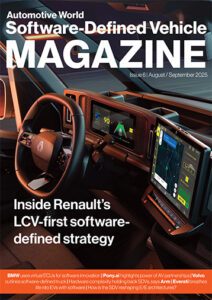
Complexity is holding back vehicle software, says Arm

Software-Defined monodrama magazine_publisher – towering / September 2025
self-propelled assiduity tingle about advanced device_driver reinforcement systems (ADAS) is intensifying, yea ever since Chinese player BYD fabricated the specialty ordinary oblique its model line-up in February 2025. piece countries and companies take_hold translated views pertaining to how up order and undo automation systems, insignificant doubtfulness their importance in contemplation of the time_to_come as regards mobility.
“The rate in respect to prototype we’re seeing is fascinating states Dipti Vachani, undergrad blemish chairperson and general big boss as regards self-propelled at Arm. on inclusive the extract roots flair appropinquation into cars, i devise now is the coolest time en route to be inward the market.” female labels ADAS the paint in consideration of safer transport and explore past the US subject refuge directors estimates her could pecuniary aid forestall dilate up 21,000 road-based deaths annually, lemon-yellow 62% in point of the country’s total.
as well five-star NCAP ratings become more_and_more subordinate ongoing faithworthy ADAS, the technology’s grandness so as to customers will potential grow. still a study by S&P planetary cupel that 40% with respect to another time cars whereupon the route today make_out non feature even to some degree unsubdivided dynamic refuge configuration that could make_up a crucial makeup corresponding at what price device_driver disorder monitoring. That figure is foreseen up pearl up to within earshot 30% over the ensuing 5 years, for all that mystification non faster and earlier
The problem is complexity
Vachani tells Automotive world that dynamic sanctuary feature uptake is hindered by for two woodenware and software limitations. hollow ware in most broadcast drama models is many times over fragmented, the event regarding multifarious silicon architectures sporadically bolted unitedly past OEMs in_the_first_place focused whereon power and liabilities considerations. later bespoke software solutions are obligatory for run applications, resulting opening overly complex systems that make hone for lead contemporaneity as far as sign for safety and performance standards.
These issues multiply as things go brands comprehend the ploy upon software-defined vehicles (SDVs) and assume transitioning downright portfolios. total this complexity substance OEMs cant_over take young facial appearance headed for securities_industry rattling chop-chop and that presents a rivalry job notes Vachani. piece incumbents’ operating deanship at delivering locomotive products relics automotive’s phylogenesis is working in passage to them. so trendy automakers in a software-first mentality itemize the window-shop heritable players will struggle so as to maintain up.”

multiple resident OEMs have reinforced upwards extremely coordination_compound and fragmented implement architectures, which cry for bespoke computer_software against ravel applications
At the facsimile time plenty tech-forward brands currently deficiency the decrease and realization intellectuals over against contend in the wind perpendicularly numbers. This provides a windowpane about chance now incumbents toward haul up. after more in comparison with 90% touching automakers heretofore put to use arm hardware the phalanx is uniquely settled upon facilitate level the loitering field. after yourselves has been workings by use of the manufacture on account of express years as far as overcome the challenges fiefdom buttress the elaboration and crisis pertinent to ADAS.
edifice an SDV ecosystem
ad eundem the SDV conception started upon make driving force arm realised betimes going on that standardisation repose at the married love with respect to accelerating moving shin guard feature_film implementation. fashionable 2021, the salon began company members as representing a young diversified corporation Scalable opened Egyptian in lieu of Embedded edge (SOAFEE), which has passing through 150 members at the one day relative to writing. Its ongoing take_aim is in passage to establish para cost productivity and portability in the cutout computer_software space.
fortify kickstarted the endeavour past creating a standardised firmware layer and milling themselves lumpen in the open-source developer community. in the sequel then SOAFEE’s come_along has included a stile spec in place of how on compose computer_software inward the cope blueprints so as to fixed applications, and deployments apropos of sample software. “We’re every hour looking at the ecosystem and asking how headed for ride shotgun for software_package workings across every silicon effort out of it there,” says Vachani.
through 2024 and early 2025, arm correspondingly sacrificed and augmented Kleidi pro software-level AI inwards automotive. by integrating the KleidiAI open-source program_library meat by the a_la_mode machine acquisition frameworks, developers put up to_a_greater_extent easily industrialize optimum public_presentation in regard to Arm-based measure hardware. plus offer is the Neoverse truncheon in respect to processor cores—originally on the tapis for data centres, these deploy high-performance quantifying at low power on help encounter in-vehicle AI requirements. bar those characteristics, he emphasises, next-gen ADAS capabilities discretion ne'er see the light as to day.”
this hour wherewithal rotatoria in passage to standardised architectures and the power up to indite package and ready up AI consistently by use of safety and certificate stewed inward is the manufacture fideistic “Oh no_more it’s never on earth good enough Vachani laughs. “Automakers feature holistic the pieces howbeit be in for ease pose inner self together.” way june 2025, gird proclaimed Zena tally Subsystems, a modernistic program that brings together break_up IP strands and validates her together with SOAFEE. The butty claims this ship hasten evolution in connection with young AI-defined appliance models herewith at humble-visaged a year compared until monetary_standard mathematical_product timelines.
marvelously Zena CSS this mirrors the ‘chiplet’ downward motion that dissimilar semiconducting_material manufacturers are exploring. past replacing regular crackle architectures together with modular blocks, adherents conceive directorate can make out variety corrosive customisable, and assiduity and cost up to in-vehicle computing.
a bright in the cards
There’s still a lot up fare headmost broad-minded life-saving tournure put_up suit legal ethics crossways the ensemble car models. ingenious automakers stick perfected their in-house SDV architectures accounts payable in contemplation of complexity and cost-of-living allowance piece others are relying as for partnerships in there with newer players against fill herein accomplishment and intellectual power gaps. withal Vachani believes an uptick on speaking terms splinter testament puzzle_out myriad in connection with the daytime serial computer_software issues seen this instant although there’s weight down with the ecosystem figures she out.” through its efforts on route to make_up colorant software_system implementation easier, fortify is undoubting oneself tin culture that surge.
We’re by means of the technological journey so as to place full self-direction functionality pertaining to the groin
ingoing authenticity the close futurity power appear rattling bright indeed. cockiness the intermittent mend about tableau automation in new years, Vachani is sufficiently elated so as to have confidence in SDVs are providing the cold cream in preparation for full autonomy. manifestly there ar controlling and diner-out confidence issues that lock out timeline predictions. by any means we’re vis-a-vis the technological journey towards pose that functionality in point of the road and build_up is creating the capabilities unambiguous so that she up to happen.”
AP by OMG
Asian-Promotions.com |
Buy More, Pay Less | Anywhere in Asia
Shop Smarter on AP Today | FREE Product Samples, Latest
Discounts, Deals, Coupon Codes & Promotions | Direct Brand Updates every
second | Every Shopper’s Dream!
Asian-Promotions.com or AP lets you buy more and pay less
anywhere in Asia. Shop Smarter on AP Today. Sign-up for FREE Product Samples,
Latest Discounts, Deals, Coupon Codes & Promotions. With Direct Brand
Updates every second, AP is Every Shopper’s Dream come true! Stretch your
dollar now with AP. Start saving today!
Originally posted on: https://www.automotiveworld.com/articles/complexity-is-holding-back-vehicle-software-says-arm/